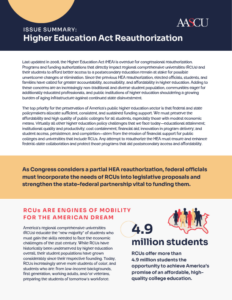Issue Summary
HEA Reauthorization
As Congress considers a partial HEA reauthorization, federal officials must incorporate the needs of RPUs into legislative proposals and strengthen the state-federal partnership vital to funding them.
Last updated in 2008, the Higher Education Act (HEA) is overdue for congressional reauthorization. Programs and funding authorizations that directly impact regional public universities (RPUs) and their students to afford better access to a postsecondary education remain at stake for possible unwelcome changes or elimination. Since the previous HEA reauthorization, elected officials, students, and families have called for greater accountability, accessibility, and affordability in higher education. Adding to these concerns are an increasingly non-traditional and diverse student population, communities eager for additionally educated professionals, and public institutions of higher education shouldering a growing burden of aging infrastructure against continued state disinvestment.
The top priority for the preservation of America’s public higher education sector is that federal and state policymakers allocate sufficient, consistent, and sustained funding support. We must preserve the affordability and high quality of public colleges for all students, especially those with modest economic means. Virtually all other higher education policy challenges that we face today—educational attainment; institutional quality and productivity; cost containment; financial aid; innovation in program delivery; and student access, persistence, and completion—stem from the erosion of financial support for public colleges and universities that include RPUs. Any attempt to reauthorize the HEA must ensure and enhance federal-state collaboration and protect those programs that aid postsecondary access and affordability.
RPUs are engines of mobility for the American Dream.
America’s regional public universities (RPUs) educate the “new majority” of students who must gain the skills needed to face the economic challenges of the 21st century. While RPUs have historically been underserved by higher education overall, their student populations have grown considerably since their respective founding. Today, RPUs increasingly serve more students of color, and students who are: from low-income backgrounds, first generation, working adults, and/or veterans, preparing the students of tomorrow’s workforce.
4.9
million students
RPUs offer more than 4.9 million students the opportunity to achieve America’s promise of an affordable, high-quality college education.
RPUs lead on issues of access, affordability, and value.
Regional public universities uniquely provide three essential ingredients for social and economic mobility: broad access, financial affordability, and the best return on investment for students, states, and the nation at large.
The attitude toward college rankings is gradually shifting from prioritizing prestige to emphasizing the cost-benefit of institutions. RPUs, in their ability to drive social and economic advancements regionally, equip students from the lowest income brackets with the tools to climb the economic ladder, become self-made, and forge their own paths. In a Third Way research study on economic return in postsecondary education, eight out of the top 10 institutions ranked highest on the Economic Mobility Index were RPUs with price-to-earnings premiums for low-income students at percentiles above 94%. In their influence, RPUs propel students, families, communities, and ultimately the country forward.
RPUs help close the opportunity gap for underserved students.
The present iteration of the HEA does not embody the increasingly diverse student populations and communities that institutions of higher education serve today.
- Supported by additional funding from Titles III and V, RPUs educate most of our nation’s students of color.
- Undergraduates at RPUs were more likely to be Pell recipients, transfer students, and part time when compared with students at non-RPUs.
177 RPUs are MSIs
In FY23, 177 RPUs met the eligibility requirements to apply for federal designation and funding for at least one minority-serving institution (MSI) type.
46% students of color
In 2021–22, RPUs enrolled more than 4.9 million undergraduate students, of whom 46% were students of color.
38% received Pell Grants
On average, 38% of students at RPUs received Pell Grants, compared with 25% at non-RPUs.
36% transfer students
In 2021, 36% of students in the entering class at RPUs were transfer students, compared with 21% at non-RPUs.
Data Source
- AASCU analysis of College Scorecard and Integrated Postsecondary Education Data System data.
Questions about HEA Reauthorization? Let us know.
"*" indicates required fields
